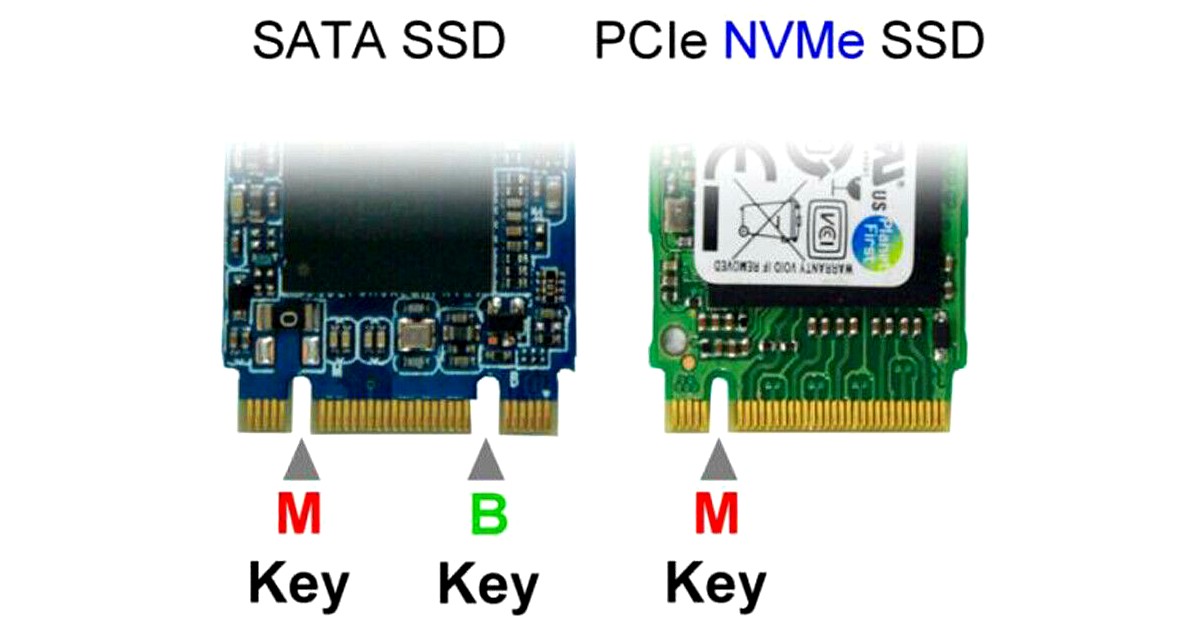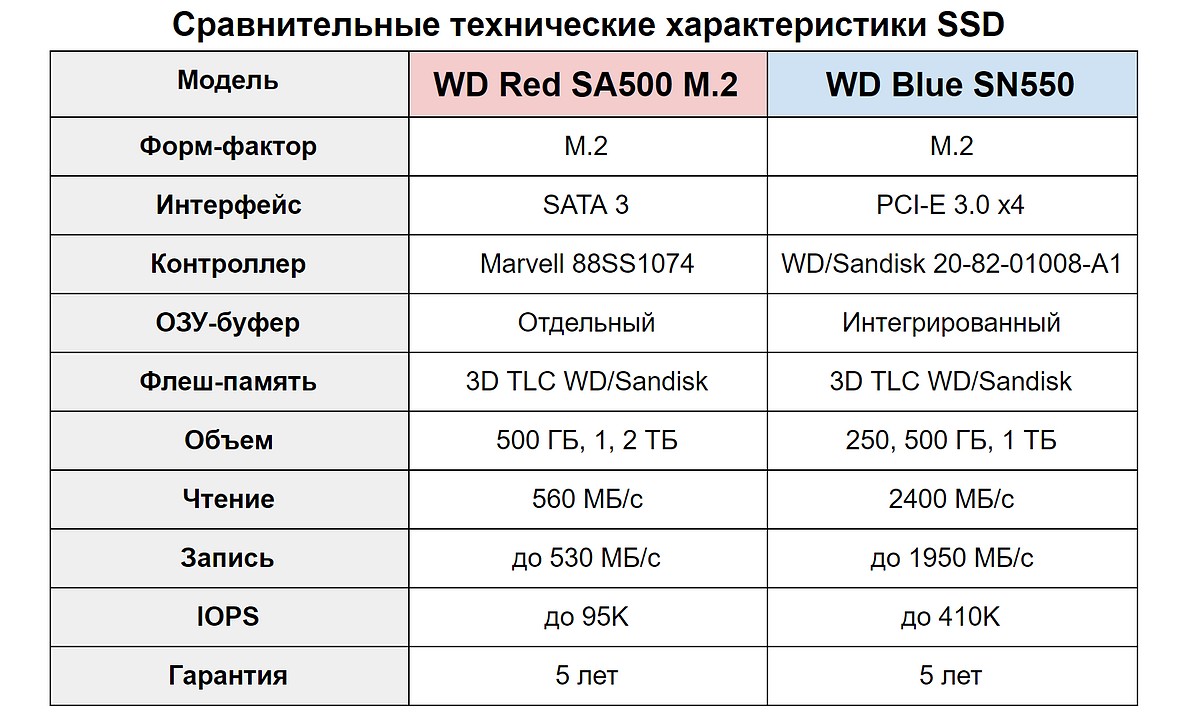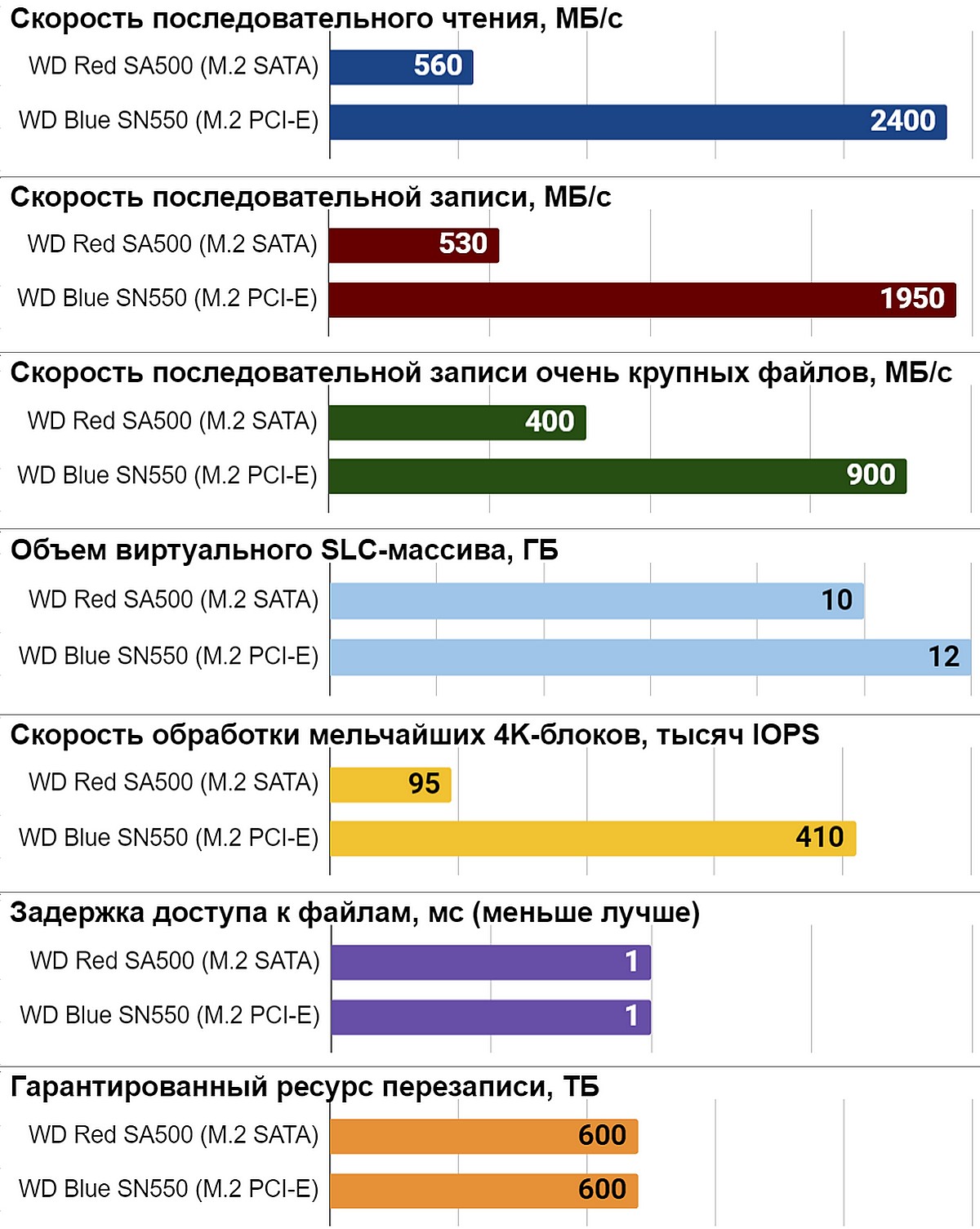What is the difference between M.2 SATA SSD and M.2 PCI-E SSD?

Big confusion
At first glance, everything is M.2 SSDs are externally identical. But often a disk that fits into the appropriate slot without any problems is not displayed either in the operating system or even in the BIOS menu. And already with a more thorough external inspection, the differences are noticeable: the M.2-disk connector has one or two cutouts (missing pins), which are called B-key and M-key.
So, drives with two B&M keys, although made in the new M format.2, but they work on the outdated SATA 3 bus (approximately 560 Mbps). Simply put, these are just smaller versions of old-school 2.5-inch SSDs. However, many laptops, in particular with the sixth and seventh generations of Intel Core processors (Skylake and Kaby Lake), are compatible only with M.2 SATA disks.
 |
Laptops, starting with the eighth generation Intel Core (Kaby Lake Refresh, Whiskey Lake) and above, already support M.2 drives with PCI-E bus (another name NVMe) and a single M. key. Motherboards for desktop PCs began to be equipped with an M slot.2 with support for both buses (SATA and PCI-E), starting with the Intel Z97 chipset (fourth-generation Haswell Refresh processors).
In addition, the bandwidth of the PCI-E bus may differ significantly. For example, the aforementioned Z97 chipset allocates only two lines of version 2.0 for the needs of M.2 SSD (labeled as PCI-E 2.0 x2, approximately 1000 Mbps). The modern low-cost Intel H310 chipset has four lines of version 3.0 (PCI-E 2.0 x4, 2000 Mbps). More functional modern chipsets Intel (B360 and above) and AMD (A320 and above) — PCI-E 3.0 x4 (3600 Mbps). And the most advanced chipsets AMD X570, TRX40 and probably the upcoming B550 are four lines of the latest PCI—E 4.0 standard (up to 7000 Mbps).
 |
And now let's move from theory to practice and take a closer look at the functional differences of SSD M.2 SATA and M.2 PCI-E on the example of the latest models of Western Digital — Red SA500 M.2 and Blue SN550 with a volume of 1 TB.
M.2 SATA solid-state drive
| Artline.ua | 3 888 ₴ | To Store |
| Comtrading.ua | 3 979 ₴ | To Store |
| FOXTROT.UA | 4 550 ₴ | To Store |
| Stylus.ua | 4 052 ₴ | To Store |
| Цифра | 3 940 ₴ | To Store |
WD Red SA500 M.2 is a solid-state drive of the "red series" of Western Digital, designed de jure for RAID arrays, NAS storage, home and small office servers. But considering that the main focus of WD Red is on increased reliability and durability, it makes sense to use this SSD in desktop PCs and laptops for professional work. The volume can vary from 500 GB to 2 TB.
As you might guess from the name, the drive is made in the newfangled M form factor.2. The connector has two B&M keys, which clearly indicates the use of the SATA 3 interface (6 Gbit/s). This implies a ceiling of linear speed: 560 Mbps for reading and 530 Mbps for writing. The above-mentioned interface is simply not capable of missing any more. Although the selected flash memory chips of WD/SanDisk's own production (now it is one company) of the 3D TLC BICS 3 type are clearly capable of more.
The high potential of the chips is confirmed by the solid speed of sequential recording of very large volumes of data at a time after exceeding the virtual SLC array — as much as 400 Mbps. It's four times faster than most other TLC SSDs, and eight times faster than low-cost QLCs. A separate chip of DDR3 RAM buffer memory adds even more speed.
The "brain" is WD Red SA500 M.2 is a dual-core, eight-channel Marvell 88SS1074 controller capable of delivering as much as 95 and 85K IOPS (I/O operations per second) with random reading and writing of the smallest files, respectively. This, again, is the ceiling of possibilities for a SATA SSD. Exactly the same controller as the flash and RAM memory chips is installed in a 2.5-inch modification WD Red SA500 WDS100T1R0A 1 TB Price from 4 037 up to 6 172 ₴. That is, the disks differ only in the form factor.
In general, the WD Red SA500 M.2 is undoubtedly one of the fastest M.2 SATA SSDs on the market. It successfully combines a multi-channel controller, a separate RAM buffer chip and selected flash memory, which guarantees high write speed even for very large files. And the rewriting resource of the terabyte model is more than 600 TB, and the warranty is 5 years. There is a WD Red SA500 M.2 and more affordable twin brother WD Blue SSD 3D NAND M.2 WDS100T2B0B 1 TB , but with a smaller operating life and a reduced warranty (400 TB, 3 years). The main thing is, before buying, check whether there is an M.2 slot in your PC or laptop, and whether it exactly supports M.2 SATA drives.
M.2 PCI-E solid-state drive

WD Blue SN550 is a bright representative of the new wave of moderately priced M.2 NVMe solid—state drives (with the M key). Compared to the previous WD Blue SN500 WDS500G1B0C 500 GB , which worked on the narrowed x2 bus, the newbie SN550 already operates with full-fledged four PCI-E lines. There were three volume options: 250, 500 GB and 1 TB (the predecessor had only two junior volumes). The rewriting resource of the older terabyte version is 600 TB, and the warranty period is 5 years.
The WD Blue SN550 was built on the basis of the latest controller of WD/Sandisk's own development, codenamed 20-82-01008-A1. Its technical characteristics are still classified, but most likely it is something in between the 20-82-007010 from the SN550 and the top-end tri-core 20-82-007011 used in WD Black SN750 NVME SSD WDS100T3XHC 1 TB with radiator Price from 9 060 up to 11 000 ₴. The linear speeds of the WD Blue SN550 are not record-breaking, but still very decent: 2400 Mbps for reading and up to 1950 Mbps for writing.
And even after the overflow of the virtual SLC array, the sequential write speed remains quite high — about 900 Mbps, which is more than twice the performance of even top—end SATA SSDs, not to mention low-cost ones. The semiconductor plants of WD/Sandisk have achieved such a high density of the layout of memory cells (96 layers) that even in the case of a maximum SSD volume of 1 TB, flash memory is represented by a single chip.
In order to reduce the cost, the WD Blue SN550 lacks a separate RAM buffer chip (but a small buffer is still integrated directly into the controller) and a metal radiator. Cooling, however, is not required for it — it is relatively cool even under prolonged load. In addition, the radiator would have to be dismantled if you wanted to install a disk in a laptop, a monoblock or a nettop. Simply put, every penny is invested in the SSD speed, and not an additional optional body kit.
A powerful controller paired with a high density layout of memory cells allows the WD Blue SN550 to process the smallest files at speeds up to 410K IOPS. Previously, only much more expensive flagship SSDs could boast of similar results. But for many tasks and professions, for example programmers working with database management systems (DBMS), the IOPS indicator is much more important than the linear speed in megabytes per second.
Configuration of the test bench
- processor AMD Ryzen 5 Matisse 3600X BOX ;
- cooler Noctua NH-U12S chromax.black Price from 3 317 up to 4 491 ₴;
- motherboard ASRock X570 Taichi ;
- RAM Team Group Dark Z Alpha DDR4 TDZAD416G3600HC18JDC01 ;
- graphics card PowerColor Radeon RX 5700 XT 8GBD6-3DHR/OC ;
- system disk WD Blue SN550 WDS100T2B0C 1 TB Price from 4 655 up to 6 053 ₴;
- additional disk WD Red SA500 M.2 WDS100T1R0B 1 TB Price from 3 885 up to 4 581 ₴;
- power supply unit ;
- housing Chieftec SCORPION 2 black ;
- monitor AOC CQ32G1 32 " black .
Test results
 |
Conclusions
Make the right choice, which of the two subspecies of SSD format M.2 is needed for you, it's not that difficult. Just by the appearance of the drive alone, namely the presence of one or two B&M keys, you can understand which bus it works on: SATA or PCI-E. Note that the PCI-E SSD speed may be limited by the interface version (2.0, 3.0, 4.0) and the number of lines (x2, x4), which depends on the motherboard chipset. Now it makes sense to buy M.2 SATA disks, perhaps, only if you have a relatively old laptop that supports only them. But if a laptop or desktop is equipped with an M.2 slot, at least the PCI-E 2.0 x4 version, you will get at least a double increase in performance over SATA. In the case of more modern chipsets, the difference in speed can reach five or even ten times. Moreover, relatively recently, low-cost M.2 PCI-E SSDs have appeared on the market, which cost almost as much as SATA.
Articles, reviews, useful tips
All materials






























